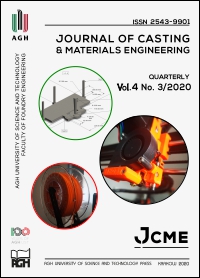A Statistical Analysis of Evaporative Pattern Casting Process Parameters for the Production of Aluminum Alloy Components
DOI:
https://doi.org/10.7494/jcme.2020.4.3.41Abstract
Four process parameters were investigated with the aim of determining their influence on the mechanical properties of some test castings, bars, cylinders and plates. The influence was quantified in terms of percentage contribution. Analysis of variance (ANOVA), regression, main effects and interaction effects plots were employed to carry out the statistical analysis. As regards the tensile strength of the test castings, the geometry of components (GOC) dominated, contributing 90.83% and the pouring temperature (PT) contributed 91.90% influence on the hardness property. These dominating potentials of these two
parameters limited the interaction of the parameters studied in the research.
Downloads
References
Clegg A.J. (1991). Precision Casting Processes. Oxford (England), New York: Pergamon Press Plc.
Kumar S., Kumar P. & Shan H.S. (2006). Parametric optimization of surface roughness castings produced by Evaporative Pattern Casting Process. Materials Letters, 60, 3048–3053.
Kumar S., Kumar P. & Shan H.S. (2007). Effects of evaporative pattern casting process parameters on the surface roughness of Al-7%Si alloy castings. Journal of Materials Processing Technology, 182, 615–623. Doi: 10.1016/j.jmatprotec.2006.09.005.
Kumar S., Kumar P. & Shan H.S. (2008). Optimization of tensile properties of evaporative pattern casting process through Taguchi’s method. Journal of Materials Processing Technology, 204, 59–69. Doi: 10.1016/j.jmatprotec.2007.10.075.
Kumar S., Kumar P. & Shan H.S. (2009). Characterization of the refractory coating material used in vacuum assisted evaporative pattern casting process. Journal of Materials Processing Technology, 209, 2699–2706.
Houzeaux G. & Codina R. (2004). A finite element model for the simulation of lost foam casting. International Journal of Numerical Methods in Fluids, 46, 203–226. Doi: 10.1002/fld.757.
Liu X.J., Bhavnani S.H. & Overfelt R.A. (2007). Simulation of EPS foam decomposition in the lost foam casting process. Journal of Materials Processing Technology, 182, 333–342.
Omidiji B.V. (2014). Evaporative pattern casting (EPC) process for production of Aluminum Alloy Components [Ph.D Thesis]. Federal University of Technology, Minna.
Omidiji B.V. (2018). Evaporative pattern casting (EPC) process. Advanced Casting Technologies. Intechopen.
Behm S.U., Gunter K.L. & Sutherland J.W. (2003). An investigation into the effect of process parameter settings on air characteristics in the lost foam casting process. Michigan Technological University, Houghton, Michigan.
Kannan P., Biernacki J.J. & Visco D.P. (2007). A review of physical and kinetic models of thermal degradation of expanded polystyrene foam and their application to the lost foam casting process. Journal Analytical Application of Pyrolysis, 78, 162–171.
Liu J., Ramsay C.W. & Askeland D.R. (1996). A Study of Foam-
-Metal-Coating Interaction in the LFC Process. Transactions of the American Foundrymen’s Society, 105, 419–425.
Yadav N. & Karunakar D.B. (2011). Effects of Process Parameters on Mechanical Properties of the Investment Castings Produced by Using Expandable Polystyrene Pattern. International Journal of Advances in Engineering and Technology, 1 (3), 9–18.


